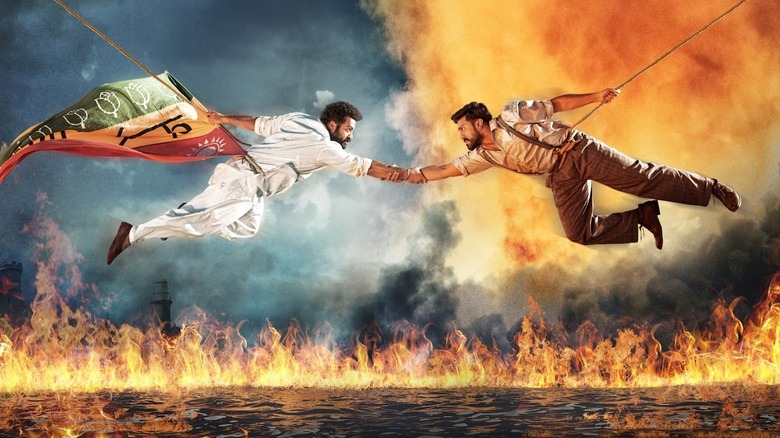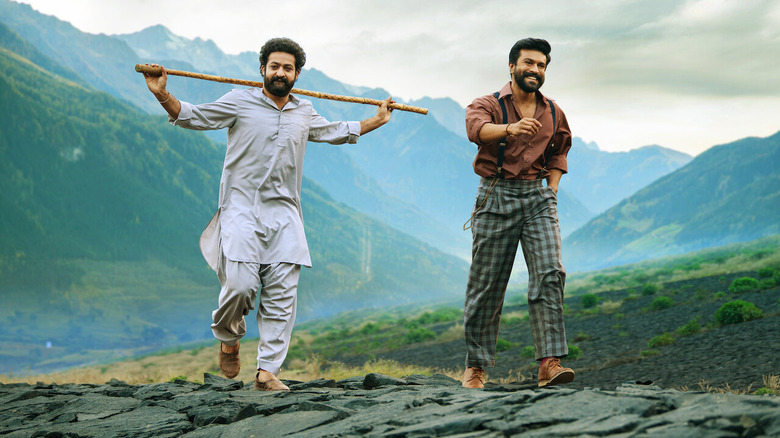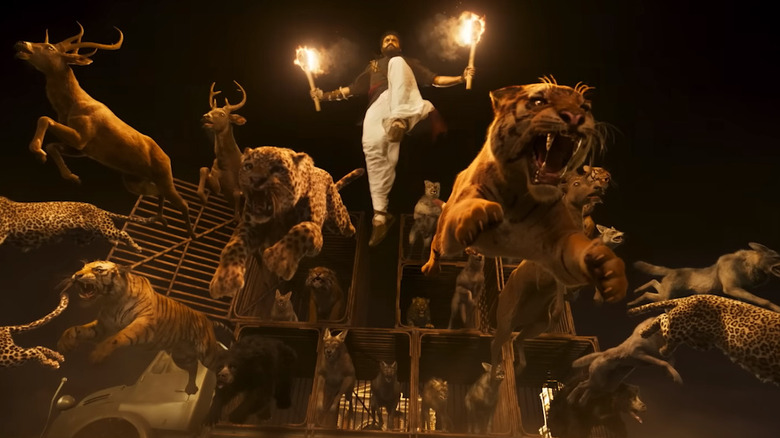The Visual Effects Artists Behind RRR Pull Back The Curtain On The Blockbuster Epic [Exclusive Interview]
"RRR" was a singular experience that may be difficult to top for some time. The Indian epic from director S.S. Rajamouli became a somewhat unexpected global hit, bringing Tollywood flare to North American audiences who were woefully unprepared for the cinematic insanity that was about to hit them in the face for three full hours. I was one of those unsuspecting moviegoers, and, quite frankly, nothing else I experienced in 2022 even came close to the blend of action, spectacle, heart, and musical numbers that this movie delivers. This is a movie.
One aspect that truly stands out among the madness is the very impressive visual effects, which outshine many Hollywood blockbusters that often have much larger budgets. The story at hand mythologizes two real-life freedom fighters who helped lead India's fight for independence from the British Raj. Komaram Bheem (N.T Rama Rao Jr., aka Jr NTR) and Alluri Sitarama Raju (Ram Charan) are at the center of this 1920s-set tale, which imagines a fictional meeting between the two, set into motion when a young girl is stolen from her village by British soldiers. From there, three hours of cinematic chaos of the finest order ensues.
So, what did it take to bring the movie's bonkers visuals to life? How does one make a truck full of wild animals let loose at a mansion seem real? I had the good fortune of speaking with visual effects head Srinivas Mohan, as well as visual effects supervisors Pete Draper and Daniel French all about it. We discuss the lengthy production, some of their favorite scenes, the surprising number of miniatures they blended with CGI, and so much more.
Note: This interview has been lightly edited for clarity and brevity.
'This isn't our first rodeo'
I know you would probably expect someone to say this, but I need to just let you guys know I absolutely love the movie. This is one of my favorite things that I've seen all year. I saw it in a packed theater and I am a huge theatrical experience guy. And when I tell you this was one of the best theatrical experiences I've ever had in my entire life, I mean it. So from the bottom of my heart, thank you guys. It was so much fun.
Mohan: Thank you. Thank you.
Draper: Oh, thanks, mate.
Starting out, this is a movie where, it's not just that it's three hours long. It's three hours and it's constantly insane. There's always something wild going on. From a visual effects standpoint, how challenging is it to not only have a movie that is so long, but a movie where there is so much on your guys' plate the whole way through?
Mohan: Yeah, this film has lot of action pieces. It's set pieces that required a lot of visual effects because it is intense emotion, and we have a lot of sequences which have slow motion, extra slow motion, and they're in broad daylight, and we cannot cheat with the darker lighting. And hyper realistic physics. These are the toughest parts to do in visual effects. Because a lot of films, they try to avoid these slow motions and try to do the darker thing. So that is one of the things which, as a visual effects supervisor or the production supervisor, for me, that is one of the big challenges.
For that, we did a lot of pre-production, like pre-visualization. We started with the concept. So this director, he develops the action sequence based on one visual he has in mind. So if you see all the animals come out of the truck, that is one visual, it's actually the entire sequence is done based on that. Even for the bridge sequence when they jump. So for me, first we need to get that visual from the concept artist. Then from there, we start developing the sequence and then, especially if we take [the] animal sequence where all animals come out, we have to make sure all the animals' timings and everything are right before shooting. Every sequence, we did a lot of pre-production work. That is one of the biggest challenges.
I guess another thing from my end is that I know the production took a long time and you guys had to deal with Covid as well. How long was it from when you guys said, "I will do the movie" to the movie getting finished?
Mohan: For me, it's like three and half years.
Oh, wow.
Draper: I think what I can actually dig out in my photos if I check the actual day. I took a photo, if you remember when we had the first discussion and it was about the attack when the scene was different. That set piece was a little bit different compared to what was actually in the final. Yeah, I think it may be a few months after you came on board, because you had a lot of stuff already in place by that particular time, didn't you?
It was about a similar amount of time, but not as long as obviously Srinivas, who came in as the primary. Going back to what you were querying earlier about how you tackle all this, this isn't our first rodeo, to be honest. We've all done this, all three of us have either A) worked in the Indian film industry previously and/or we've worked with this particular director, and we're all on the same sort of wavelength. So you class yourself as an extension of the path, sort of thing. We can generally anticipate it. I genuinely didn't think it felt like three years. It didn't feel like it. The delays with Covid, obviously the release and what have you, when everything was like, "Okay, pens down," that felt like a drag because we were like, "We want to get this done, we want to finish this thing." We wanted to finish it to A) get it out the door, and B) we wanted everyone to see what we'd been doing and all the shots that we completed 18 months prior were just [sitting] there, and we really wanted everyone to see the thing. That was the biggest kicker for me, anyway.
French: Yeah, I don't remember the exact date, but I think we got on board in December 2018. We had the initial discussion. I got on board with my team pretty early, because we do miniatures as well. So miniatures are made at the same time as principal photography. So we got on board pretty early, and then it transitioned into CG work and digital set extensions and all that. So by the time we finished, it was three years at least. So it's been a long ride, but it's been awesome.
'I think it's just a matter of choosing the right tool for the job'
Daniel, I'm a big James Bond guy, and they use a lot of miniatures. There's been a lot of focus on the CGI and the visual effects in that sense in this movie. But can you talk about how the miniatures were incorporated a bit? I would love to know more about that.
French: I've always been a huge fan of miniatures myself. I think it's a great tool to have in your toolbox. Since CG has become such a big tool, everyone's kind of throwing miniatures out as an old, obsolete tool. But I think that's a mistake. I think it's still a viable option for a lot of effects, and especially when it comes to physical effects like fire and explosions and so on. Obviously, you have to build them large enough to hold up in camera. You can't use small model trains, tabletop size. You need some bigger ones, because you can't scale fire, obviously.
So, Srinivas reached out to us to get a part of the bridge together with some train cars to explode — that whole sequence with the kid being rescued. A lot of those shots are actually miniature, and then the bridge and everything is extended from there. We're basically using the best tool for the job in each shot. Some of the shots are a full-size train car being flipped, some of them are miniatures, and in some cases, we use full CG. I think it's just a matter of choosing the right tool for the job. I see miniatures as a visual effect. If you go back to the '90s and '80s, and before that, all visual effects, pretty much, were done as miniatures. To me, it's just borrowing some of those old techniques that still work and blending it with new ones.
Mohan: Yeah. Apart from the bridge sequence, we have a few other miniatures.
Draper: So I found the date! I found the date. It's 26 of March 2018.
Oh, wow. Over four years later, here we are talking about it.
Mohan: So the miniatures, apart from the bridge sequence, we have used [them] in some other sequences. One is at the end with the whole building, that glass, the dome and everything, that we had in miniature. Then there is one truck which enters into the visual, the animals come out of the truck, and the truck which goes through the wooden door, that is actually miniature. I always like to do a lot of things in practical as much as possible. That's why I went to Daniel, because they're good at miniatures. And then from there, later I extended that some of the way, because they already have a visual effects strength along with the miniatures. So we continued from there.
There's so much stuff happening in this movie, and so many impressive visuals. Did you guys end up, at the end of the movie, each one of you, did you have a favorite shot or effect?
Draper: It was our opening shot for [Ram] Charan's introduction. Scene two, shot one. That one specifically. And the second one was Charan's fireworks dispersal, the big kind of Ram shot when we got that nicely art directed spirals going behind him, and all the fireworks going through shot and that kind of thing. That was like, "Yeah, money." That was time well spent on those, without a doubt.
What about you, Daniel?
French: Yeah, I think in my case at least — there's so many nice shots in the film, but I think the most rewarding one was probably the long pullout from the festival area where Charan comes running out and the camera pulls back over the bridge and you see kind of the whole village and that whole scene. That was one of the first shots we started working on, because it defined the whole area for the whole sequence, basically, and one of the last shots to go out the door. We continued working and refining that shot throughout basically the three years we were working on the film. It's just a long pullback, but it started — the first beginning of the shot is a cable cam move. Then from there, everything is CG, but it kind of defines our whole sequence. After that, obviously, there's a lot of cool slow motion shots and what have you. But I think for me, that's the most rewarding one.
Draper: The fun thing about that particular shot is that we were the culprits to actually pre-vis that. As soon as we'd done it, we're like, "Whoever's doing this next, I'm really sorry," because, again, this is a money shot. This is one where you've got to spend a lot of time on the amount of stitch work, and the amount our set builder's got to do. You see this on screen, it's going to be one of those shots. It's going to be a "Wow." Not just go from a cut to a wide. It's like, no, we're traveling back, we want to see that distance. We keep going, we keep going. It's like it doesn't stop. It just keeps going, going, going.
French: And the seams and everything — it has to be seamless, right?
Draper: As a technician, whenever you see a film, you're partly going into technical standpoints of like, "Oh, oh, matte issue. Oh ah, rotor issue. Oh, that black didn't match that black, or that whole lighting on that didn't match" and so on and so on. But I'm there looking at this, seeing it on the screen. I'm like, "No, can't see anything wrong. Nothing." That good. I just turned my brain off. It was nice.
Mohan: It took almost two and a half years to finish the shot.
Draper: It shows.


